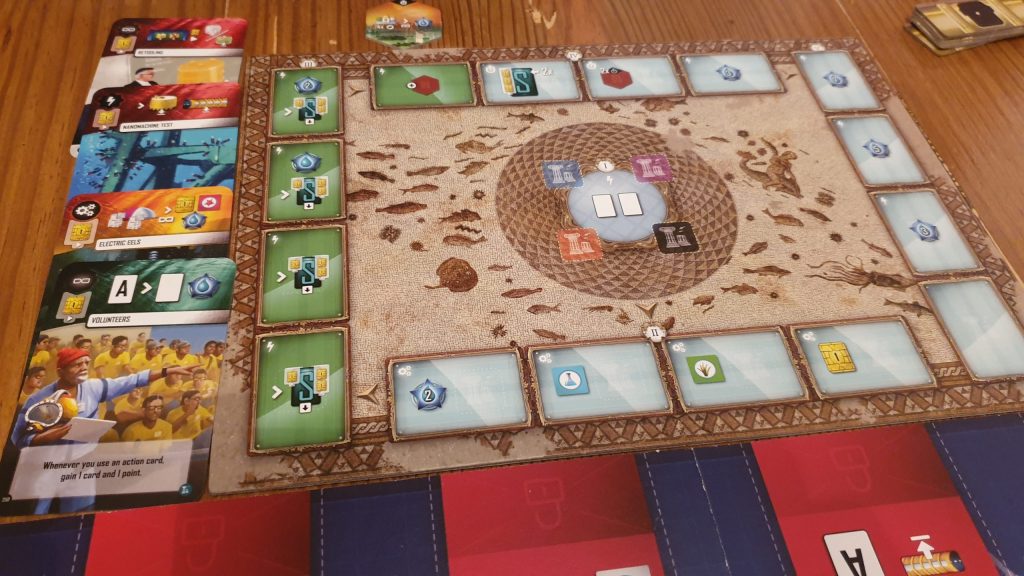New Discoveries is the first expansion for Underwater Cities, a city building and worker placement game from Delicious Games. Designed by Vladimír Suchý, featuring artwork from Milan Vavroň, this expansion is about adding modules to the game – rather than an overhaul. New metropolises will be connected to, players will start with asymmetrical assistants and discoveries will be made. However, is this expansion like discovering treasure or is it as thrilling as a desalination plant? Let’s find out!
The first module of the expansion effects Underwater Cities from the very start of the game. Introducing Quick Start this mode swaps in powerful and asymmetrical personal assistants, and starting resources. The new assistants mostly follow a basic pattern: they have a better action, also coming with a production output. Not every card fits this style, like Headhunter that sees the player choosing a 1 or 2 credit Special card from three to instantly play for free. Regardless of what they do just make sure everyone uses them or noone does – they are vastly superior to the original basic assistants. Choosing to use Quick Start also sees the round marker start on round 2, making each Era neatly have three rounds.
As if the choice of building to the metropolis areas, or standard board bonuses, weren’t enough the Museum board module adds a race to the choices. Upon building elements that cover a museum symbol the player gets to add a discovery token to the next stage of the museum. Each discovery instantly gets the player a small bonus, then there are museum phased bonuses. Phase 1 of discovery is the same for all players, being gain 2 cards, regardless of using the A or B side of the board. From then on the race begins. Each future stage has different options, ranging from production of points to unlocking the new green metropolises. Whomever is first to trigger that phase gets the first pick – often taking the best space.

In a 2 player game none of the spaces feel that much worse, as they progressively decrease as slots get filled. Therefore, when playing with 2 the second player still gets the second best option. Add more players to the mix and the difference between first and last can be 7 victory points, or more via some of the end game multipliers. This really sees discoveries become something to be rushed towards, though players rarely have to go vastly out of their way to trigger them.
New cards for the three Eras and specials are included. These shuffle straight into their respective decks, almost to be forgotten about. Adding more variety, there are some interesting options, though none stray far from what was possible in the base game. Different combinations are mostly what the Era cards offer, with a few new ways to score from the special cards. In particular, the way that these cards never need to be removed is a great strength of the expansion. None reference expansion only symbols. So, regardless of if you’re using content such as the museum, or not, they can be left in – with new players none the wiser or worse off.
Despite this there is a small symbol on each card denoting they are from the expansion just in case you want to split the deck back out. Another way to split the cards out is a slightly noticeable component problem of the expansion. The Era 1 and 2 card backs have a minute colour difference from those of the base game. Some may have a large issue with this, though a few players have been unable to tell the difference. With the vastness of the Era decks, and the fact that a good amount of cards are added, it isn’t like you can tell the exact cards that someone has, or what will be drawn next. Therefore, this can go down more as a production oddity rather than an expansion breaking issue.
As mentioned in the review of the base game, the player boards weren’t a huge problem. Neither were they great quality, being somewhat thin card. New Discoveries completely changes that with 3 layer player boards. While other games have done double layer player boards, like Scythe, triple layer player boards are somewhat of a new thing. It makes sense as the player boards in Underwater Cities were double sided and that continues, with the dual layer on both sides. They make the game feel more premium, something slightly missing from the base game. The only incredibly minute caveat is that the player boards make one of the metropolis tiles be at a slight angle. It’s slightly annoying to look at visually but otherwise is a forgettable non-issue.
Some were put off by the speed of the first rounds of Underwater Cities. New Discoveries looks to fix that with a Terraforming Mars Prelude like asymmetrical resource boost at the start of the game. The majority of the new content is decent, blending seamlessly with the original content. Alas, the expansion will blend too well for some, it is mostly little additions here and there, with only the museum board being something truly different.
For those wondering, all of the Underwater Cities New Discoveries content fits into base game box, with a few mm lift on lid. That is unless players are happy to ditch the player boards from the base game – which come triple layered in the expansion anyway. This is an expansion for fans of the game, looking for a little more game without major disruptions to the experience they already enjoy. There is only one hesitation to recommending the expansion. The, albeit awesome, triple layer player boards could have been sold separately; allowing players with the base game to pick them up as an upgrade and making the other expansion content available for cheaper.
(Editor’s Note: Underwater Cities New Discoveries was provided to us by the publisher for the review at Essen Spiel 2019.)



